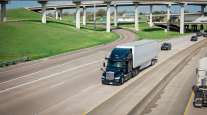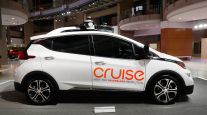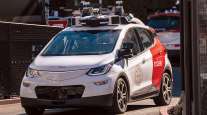GM’s Cruise to Deploy Driverless Cars in San Francisco

[Stay on top of transportation news: Get TTNews in your inbox.]
SAN RAMON, Calif. — General Motors’ self-driving car company is sending out vehicles with nobody behind the wheel in San Francisco as it navigates its way toward launching a robotic taxi service that would compete against Uber and Lyft in the hometown of the leading ride-hailing services.
The move announced Dec. 9 by GM-owned Cruise comes two months after the company received California’s permission to operate fully driverless cars in the state.
Like dozens of other companies testing the robotic technology, Cruise’s self-driving cars have been allowed on California public streets for several years with humans poised behind the wheel to take over in an emergency. Now, Cruise is confident enough to send out its self-driving cars without that safety net, although they still will be monitored by humans from remote locations instead of inside the vehicle.
“We believe self-driving has the potential to upend transportation,” Cruise CEO Dan Ammann said Dec. 9.

In this special two-part year in review, we look at the technology and regulatory developments that will help you and your business in 2021. Transport Topics Reporter Eleanor Lamb and Managing Editor for Features Seth Clevenger discuss HOS, software, equipment and more. Hear a snippet, above, and get the full program by going to RoadSigns.TTNews.com.
California regulators also recently approved new rules allowing ride-hailing services to pick up passengers in self-driving cars, but Cruise isn’t going down that road yet.
Instead, Ammann pledged the company will move cautiously while dispatching up to five fully driverless cars into parts of San Francisco initially. Cruise’s employees most likely will be the only passengers initially riding in the fully driverless cars, just as they were when the company was testing the vehicles with a human backup behind the wheel.
Ammann declined to provide a timeline when asked if Cruise planned to use its driverless cars in a ride-hailing service within San Francisco next year. But he said Cruise remains on a clear path toward “a commercial product that everyone can use.”

Ammann
Cruise, which GM bought in 2016, had initially set a goal of using driverless cars in a ride-hailing service by the end of last year, but perfecting the required technology has proven far more challenging than some of the world’s top robotic engineers envisioned when they started working on their driverless technology anywhere from 5 to 10 years ago.
Google’s Waymo also has had to move more slowly with a robotic ride-hailing service it launched in the Phoenix area two years ago. That service, though, has been able to steadily expand since its debut, and Waymo also has a permit to deploy fully driverless cars in California, although the company hasn’t yet indicated when it might do that.
Three other companies have California permits to operate fully driverless cars in the state: AutoX Technologies, delivery service Nuro and Amazon’s Zoox, which recently posted a video promoting a Dec. 14 announcement about its future direction.
Cruise has spent the past five years testing its technology that has been used in 2 million miles of self-driving to reach this point in its evolution.
Want more news? Listen to today's daily briefing:
Subscribe: Apple Podcasts | Spotify | Amazon Alexa | Google Assistant | More




